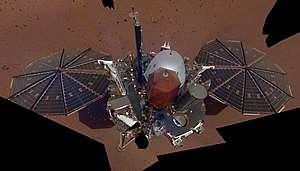K2-141b
K2-141b (also designated EPIC 246393474.01) is a massive rocky exoplanet orbiting extremely close to an orange dwarf star. The planet was first discovered by the Kepler space telescope during its K2 “Second Light” mission and later observed by the HARPS-N spectrograph. It is classified as an Ultra-short Period (USP) and is confirmed to be terrestrial in nature. Its high density implies a massive iron core taking up between 30% and 50% of the planet's total mass.[2]
| Discovery | |
|---|---|
| Discovery site | Kepler Space Observatory |
| Discovery date | 2018 |
| Transit | |
| Orbital characteristics | |
| 0.00716 + 0.00055–0.00065 AU (1,071,000 + 82,000–97,000 km)[1] | |
| Eccentricity | 0[1] |
| 0.2803244 ± 0.0000015 d (24,220.03 ± 0.13 s; 6.727786 ± 3.6×10−5 h)[1] | |
| Inclination | 86.3 +2.7 −3.6[1] |
| Star | K2-141 |
| Physical characteristics | |
Mean radius | 1.51±0.05[1] R⊕ |
| Mass | 5.08±0.41[1] M⊕ |
Mean density | 8.2 ± 1.1 g/cm3 (4.74 ± 0.64 oz/cu in) |
| 2.23 +0.35 −0.31 g | |
| Albedo | ~0.30±0.6 |
| Temperature | 2,039 K (1,766 °C; 3,211 °F) (equilibrium)[1] 3,000 K (2,730 °C; 4,940 °F) (day side)[2] |
Characteristics
Mass, radius, and temperature
Like the majority of known exoplanets, K2-141b was detected using the transit method, where a planet blocks a tiny fraction of its star's light as it passed between our line of the sight and its host. This method is only able to determine the radius of the planet, not its mass. However, K2-141b was also detected by the radial velocity method using the HARPS-N spectrograph. Therefore, its mass could also be determined along with its radius. The planet is classified as a Super-Earth, being significantly larger and more massive than Earth but not as large as the ice giants Uranus and Neptune. K2-141b has a radius of 1.51 R⊕, below the 1.6 R⊕ threshold where most planets are expected to accumulate thick hydrogen and helium atmospheres, transforming them into Mini-Neptunes. The planet's mass confirms that it is rocky. It has a mass of 5.08 M⊕, which gives K2-141b a high density of 8.2 g/cm3, about 1.48 times the density of Earth. This high density implies a composition with a large iron core taking up about 30% to 50% of the planet's total mass.[2]
Despite its terrestrial nature, K2-141b is far from habitable. Its extremely close proximity to its host star has resulted in an equilibrium temperature of about 2,039 K (1,766 °C; 3,211 °F). However, the actual temperature is probably much higher. The secondary eclipses of K2-141b indicate a dayside temperature of around 3,000 K (2,730 °C; 4,940 °F), with a bond albedo no greater than 0.37, or a geometric albedo of about 0.30. Further observations are needed to distinguish between the two scenarios.[2]
Orbit
K2-141b has one of the shortest known orbital periods of any confirmed exoplanet. One orbit takes just 0.28 days to complete – a mere 6.7 hours. Only a few planets, including those around Kepler-70, have shorter orbital periods. At this proximity, K2-141b is most likely tidally locked with its host star. It has a semi-major axis of 0.0074 AU, just 0.74% the distance between Earth and the Sun.
Host star
K2-141 is an orange main sequence star about 61 parsecs away in K2 Campaign 12, within the constellation Aquarius. It has a radius of 0.681 R☉ and a mass of 0.708 M☉. It has a temperature of 4599 K and is between 1.6 and 12.9 billion years old. For comparison, the Sun has a temperature of 5778 K and is 4.5 billion years old.
See also
References
- "K2-141 b CONFIRMED PLANET OVERVIEW PAGE". NASA Exoplanet Archive. Retrieved 2018-03-05.
- Malavolta, Luca; et al. (2018). "An Ultra-short Period Rocky Super-Earth with a Secondary Eclipse and a Neptune-like Companion around K2-141". The Astronomical Journal. 155 (3). 107. arXiv:1801.03502. Bibcode:2018AJ....155..107M. doi:10.3847/1538-3881/aaa5b5.

